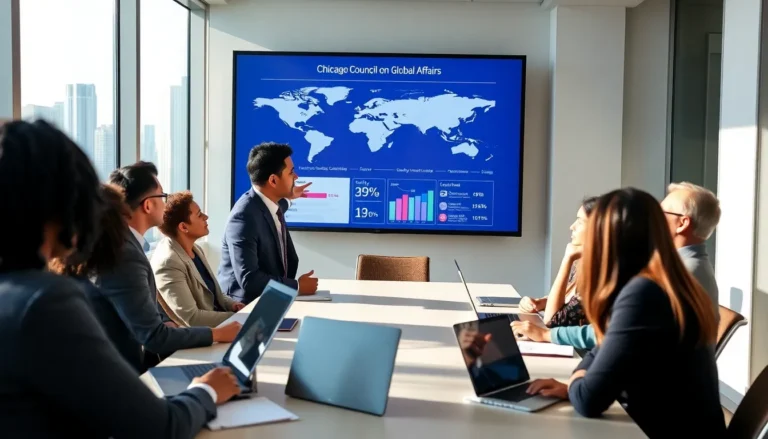Table of Contents
ToggleIn an ever-evolving global landscape, international security trends play a crucial role in shaping diplomatic relations and national policies. As threats become more complex, nations must adapt to new challenges that range from cyber warfare to terrorism. Understanding these trends is essential for policymakers, analysts, and citizens alike, as they navigate the intricate web of global security.
Recent developments highlight the shift in focus towards non-traditional security threats, emphasizing the importance of collaboration among nations. With the rise of technology and globalization, traditional military power alone isn’t enough to ensure safety. Instead, countries are increasingly prioritizing intelligence sharing, cyber defense, and counter-terrorism efforts. This article delves into the current trends in international security, examining the factors that influence them and their implications for the future.
Overview of International Security Trends
International security trends reflect the changing dynamics of global threats. Cyber warfare has emerged as a primary concern, with nations increasingly targeted by sophisticated cyber attacks. Governments are enhancing cyber defense mechanisms and investing in resilience strategies to protect critical infrastructure.
Terrorism remains a persistent threat, evolving in methods and reach. Non-state actors exploit geopolitical tensions and technological advancements, making it essential for nations to strengthen counter-terrorism efforts. Collaborative intelligence-sharing has gained importance, enabling countries to anticipate and respond to terrorist activities more effectively.
Non-traditional security threats encompass issues like climate change, pandemics, and resource scarcity. The interconnected nature of these challenges emphasizes the necessity for multilateral cooperation. Nations recognize that addressing these threats requires a comprehensive approach that includes diplomatic, economic, and military strategies.
The landscape of international security is further shaped by geopolitical shifts. The rise of emerging powers influences regional stability and creates new alliances and rivalries. This changing environment necessitates adaptive strategies to manage emerging threats and ensure lasting security.
Security priorities are shifting towards humanitarian considerations and human rights. Armed forces are increasingly tasked with protecting civilians during conflicts and addressing the aftermath of crises. This focus on human security reshapes military engagements and reflects a broader understanding of security.
International security trends underscore the need for continuous adaptation. The evolving nature of threats demands innovative solutions and collaborative frameworks. Countries must remain vigilant and proactive in addressing both traditional and non-traditional security challenges.
Key Global Challenges

International security faces numerous critical challenges that demand immediate attention and strategic responses. The rise of non-traditional threats significantly impacts global stability and safety.
Cybersecurity Threats
Cybersecurity threats pose significant risks to national security and critical infrastructure. Data breaches, ransomware attacks, and state-sponsored cyber operations are increasing in frequency and sophistication. Governments invest heavily in cybersecurity measures to safeguard sensitive information and ensure operational continuity. A Government Accountability Office report noted that 40% of U.S. federal agencies experienced cybersecurity incidents in 2020. Heightened focus on public-private partnerships enhances resilience and promotes information sharing among stakeholders.
Terrorism and Extremism
Terrorism and extremism continue to evolve, with non-state actors exploiting political instability and technological advancements. Organizations like ISIS and Al-Qaeda adapt their tactics, utilizing social media for recruitment and coordination. In 2022, the Global Terrorism Index reported over 6,700 terrorist attacks worldwide, affecting thousands. Nations prioritize counter-terrorism efforts through intelligence sharing, capacity building, and community engagement initiatives. Collaborative efforts aim to disrupt extremist networks and prevent radicalization.
Geopolitical Tensions
Geopolitical tensions rise as emerging powers challenge historical hierarchies and established norms. Conflicts in regions like Eastern Europe and the South China Sea unsettle international stability, leading to military buildups and strategic alliances. According to the Stockholm International Peace Research Institute, global military expenditure reached $2.2 trillion in 2021, reflecting increased emphasis on national defense. Countries adapt strategies to navigate these complexities, focusing on diplomacy and conflict resolution while reinforcing defensive postures.
Emerging Technologies in Security
Emerging technologies significantly impact international security trends, providing new methods for both defense and threat mitigation. Two notable advancements are artificial intelligence and autonomous systems, which are transforming the landscape of security.
AI and Surveillance
AI enhances surveillance capabilities, enabling real-time analysis of vast data sets. Governments employ AI algorithms to monitor public spaces and detect suspicious activities, reducing response times to incidents. Facial recognition technology, powered by AI, raises concerns about privacy and civil liberties, leading to debates on ethical implementation. A study by the Center for Strategic and International Studies revealed that 66% of countries use AI in their security operations, underscoring its widespread adoption. Monitoring social media platforms with AI analyses trends in terrorist recruitment, providing insights for preemptive actions against threats.
Drones and Autonomous Systems
Drones and autonomous systems have revolutionized security operations by providing surveillance and tactical capabilities. Unmanned aerial vehicles (UAVs) allow for reconnaissance missions without risking personnel, enhancing situational awareness. In 2021, the U.S. Department of Defense spent over $6 billion on drone technology, indicating significant investment in these assets. Additionally, autonomous systems assist in logistics and supply chain management within military contexts, streamlining operations and enhancing efficiency. However, the proliferation of drone technology raises concerns about their use in asymmetric warfare, prompting discussions on regulatory frameworks to govern these evolving technologies.
Regional Security Trends
Regional security trends reflect unique challenges and dynamics within specific areas, shaping how nations respond to security threats.
Asia-Pacific Developments
Asia-Pacific faces significant security developments, driven by territorial disputes and military expansion. The South China Sea remains a focal point, with China asserting claims over crucial shipping lanes, leading to increased naval presence from regional players like the U.S., Japan, and Australia. In 2021, military spending in the region grew by 5.7%, underscoring heightened tensions. North Korea’s continued missile testing has escalated concerns, prompting discussions about collective security agreements among neighboring countries. Cyber threats originating from North Korea also pose risks, with incidents targeting South Korean infrastructure noted in 2022. Consequently, nations are enhancing collaboration on intelligence sharing and joint military exercises to address these evolving threats.
European Security Dynamics
European security dynamics are influenced by rising geopolitical tensions, particularly related to Russia’s actions in Eastern Europe. In 2022, Russia’s invasion of Ukraine triggered a reassessment of NATO’s defense posture, resulting in increased military deployments and a commitment to enhance collective defense measures. European military spending reached $350 billion in 2022, with many countries investing in new technology and capabilities. Simultaneously, the influx of refugees from conflict zones adds social strain, necessitating integrated security responses that address both humanitarian needs and national security concerns. Cybersecurity threats remain significant, with European nations focusing on strengthening their capabilities to defend against state-sponsored cyber attacks.
Middle East Conflicts
Middle East conflicts continue to be shaped by longstanding tensions and emerging threats. The Syrian civil war persists, with various state and non-state actors involved, complicating peace negotiations. In 2021, over 2 million Syrians accessed humanitarian assistance, highlighting the importance of humanitarian security considerations. Iran’s influence in the region remains a pivotal factor, as its support for militant groups strains relations with Israel and Gulf states. In 2022, the Abraham Accords facilitated normalization efforts, yet underlying tensions persist, particularly regarding Palestinian statehood. Additionally, terrorism remains a high-risk factor, with ISIS and other extremist groups maintaining operational capabilities across various countries. Nations are increasingly adopting multi-faceted approaches that encompass military, diplomatic, and socio-economic strategies to manage these complex challenges.
The Role of International Organizations
International organizations play a crucial role in addressing global security challenges. They facilitate cooperation, enhance dialogue, and provide frameworks for conflict resolution.
United Nations and Peacekeeping
The United Nations (UN) significantly influences international security through its peacekeeping missions. Peacekeeping operations deploy troops and officers from various nations to conflict areas, fostering stability and aiding humanitarian efforts. In 2022, the UN maintained 12 active peacekeeping missions, with over 90,000 personnel on the ground. These missions focus on preventing violence, protecting civilians, and supporting political processes. The UN also provides a platform for nations to address grievances, promoting diplomatic solutions over armed conflict. Additionally, the UN’s policies on disarmament and non-proliferation contribute to reducing the threat of conventional and nuclear warfare globally.
NATO’s Evolving Strategy
The North Atlantic Treaty Organization (NATO) adapts its strategy to confront contemporary security threats and evolving geopolitical dynamics. In response to Russia’s increasing assertiveness, NATO reinforced its deterrence posture by implementing the Enhanced Forward Presence in Eastern Europe since 2017. This initiative involves the deployment of multinational battlegroups, enhancing collective defense capabilities. NATO’s 2022 Strategic Concept outlines a focus on collective defense, crisis management, and cooperative security, addressing challenges such as cyber threats and hybrid warfare. NATO also emphasizes collaboration with partner organizations and non-member states to enhance regional stability, demonstrating a commitment to collective security and crisis response in an interconnected world.
International security trends are rapidly evolving in response to a complex array of threats. As nations face challenges from cyber warfare to climate change, collaboration and innovation are essential. Countries must adapt their strategies to prioritize intelligence sharing and resilience, ensuring they remain prepared for both traditional and non-traditional threats.
The landscape is shifting towards a more integrated approach that includes humanitarian considerations and the protection of human rights. By leveraging emerging technologies while addressing their implications, nations can enhance their security frameworks. Ultimately, a proactive and cooperative stance will be crucial for navigating the intricacies of modern security challenges and fostering global stability.





